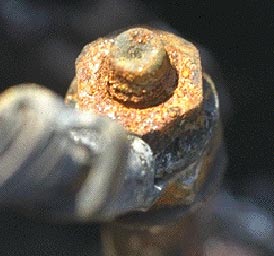Process: Evidence Can Be Difficult to Find
Process: Evidence Can Be Difficult to Find
Beware: Short circuits, arcs, and overheated wires also occur after fire initiation
There may be many arcs or shorts that occur as a result of a fire, depending on the extent of the fire. Evidence of arcing or wire beading may have occurred after the fire was initiated. Unfortunately, when there has been a complete burn-down of a vehicle, where no combustibles remain, there is no reliable means to distinguish between an internally and externally heated wire. There is no discernable metallurgical difference in a copper wire that has been exposed to internal heat as compared with external heat. There are some controversial methods (that have been proposed and published) to determine whether an arc was the cause or result of a fire, but none have been proven to be reliable. To learn more about this topic, click here.
 Photograph of battery cable short against housing as a result of burn damage to insulation after fire initiation. |
Arcing is difficult to detect, particularly in small wires
There are many hundreds of feet of wiring in an automobile. Small arcs may be difficult to find after fire damage, collision damage, or in large wire bundles that are difficult to access. Also, the arc evidence can be subtle and nearly microscopic. Other evidence, including witness statements, may be necessary to corroborate a theory of electrical ignition.
 In this 1993 Honda Prelude collision fire, the energized alternator terminal was forced through a steel shroud. (Arrow shows the area of the alternator; front of vehicle is to the right in the photograph.) |

The alternator positive terminal stud, located at the front of the engine compartment, must have been powered at the time of contact with the steel shroud, yet neither the stud nor the shroud showed any evidence of arcing or material transfer. It may be that the contact was so fast and secure that there was no opportunity to form a parting arc. This is an example in which there was a known short and no clear evidence of arcing remained.
Poor connections and deficient insulation may not be evident after the fire
Fire often destroys or consumes the very evidence of its cause. Threaded connections can loosen (or appear to loosen) in a fire from expansion of the metal, or from heat consumption of washers or other components in the connection. Also, loose connections can corrode after a fire, giving them the appearance of being tight.